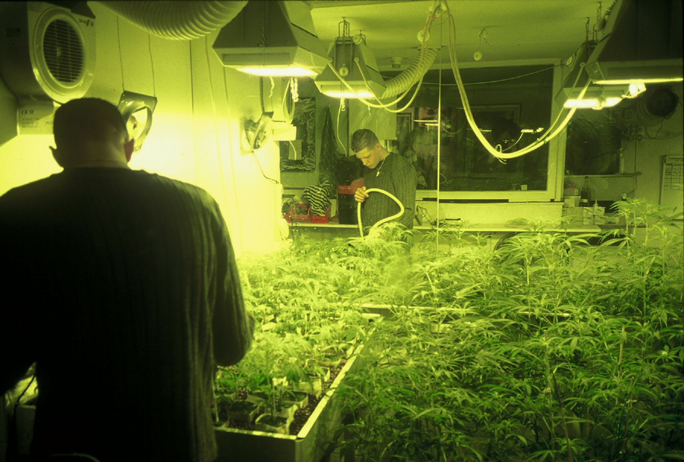
Cannabis Cultivation Amsterdam. Photo by Chris Kilham
Denver, the mile high city, is re-earning its name as legal cannabis is raising spirits and revenues in Colorado, the cowboy and cattle ranching state. Thumbing their noses at federal lawmakers by legalizing both medical and recreational cannabis use, the Colorado lawmakers anticipate taking in a whopping $134 million in taxes on legal pot sales this year. And that’s just the beginning.
High revenues from getting high got a major lift from Federal Attorney General Eric Holder’s announcement in January that U.S. treasury officials, wishing to cash in by taxing stoner dollars, will soon issue new regulations regarding banking services for state-approved cannabis concessions. Banks in those states where pot is legal for medicine or recreation will now be able to offer business loans to pot entrepreneurs and hold revenues from lucrative marijuana, without winding up in the slammer alongside many of the 750,000 Americans busted each year for possession or sale of ganja. Instead of spending approximately $10 billion annually fighting the hopelessly futile battle of pot criminalization, feds hope to top up the nations’ budget with a gravy train of revenues. Time will tell whether this becomes a new revenue stream for funding schools and roads, or a bongs-for-bombs proposition.
President Obama threw his hat into the green ring just days before the Holder announcement, with a seemingly off-the-cuff yet very well orchestrated set of comments on pot, as “a bad habit and a vice,” yet no more dangerous than alcohol. Unlike Bill Clinton, Obama admits inhaling, on many occasions. His comments indicate a seismic shift in the federal position on cannabis, and have sent tremors through the alcoholic beverage industry, whose members worry that at least some American booze revenues will go up in smoke. The slogan “This bud’s for you” is already taking on new popular meaning.
Meanwhile, In Colorado and Washington state, those who offer products rich in the non-psychoactive marijuana ingredient CBD or cannabidiol, are receiving visitors from all over the nation, who are afflicted with chronic pain, MS, epileptic seizures, neurological disorders, and other health complaints that may respond positively to cannabis treatment.
A new pyramid sales company, Kannaway, is launching its own CBD-rich hemp oil for medical purposes, and predicts astronomic growth through a “hemp lifestyle,” even though its product will be significantly more pricey than the same item sold by other means. Other suppliers aren’t sitting on their hands waiting to sell cannabidiol capsules, tinctures, and oral syringes. Instead, the CBD market is brisk and growing exponentially. To quote former presidential candidate John Kerry, help is on the way.
Meanwhile, NORML, the DC-based national Organization for the Reform of Marijuana Laws, is working harder than ever to beat pot prohibition once and for all, hoping to push states whose voters are receptive to medical marijuana over the voting edge in upcoming ballot initiatives. According to NORML, “Marijuana is the third most popular recreational drug in America (behind only alcohol and tobacco), and has been used by nearly 100 million Americans. According to government surveys, some 25 million Americans have smoked marijuana in the past year, and more than 14 million do so regularly despite harsh laws against its use.” Prisons, many of them for-profit private enterprises, will just have to identify other citizens to incarcerate.
Sympathetic media, including two recent extensive special CNN programs entitled Weed 1 and Weed 2 have shown the American public the medical benefits of CBD, and have confronted the US government on its highly embarrassing pot patent, filed by the Department of Health and Human Services. Government officials, tens of thousands of them hiding behind a smokescreen of stony silence, couldn’t be reached for comment. Meanwhile, Weeds, the cable TV hit show about a suburban pot dealer, continues to fare well in video stores and on re-runs, despite its cancellation in 2012.
Concerned educators point out that pot isn’t right for youth, and can damage their ability to learn. Like alcohol and tobacco, cannabis seems on a course similar to those drugs, destined to be legally an adult-only product, though in fact widely available to all. Pot use among the young is bound to result in a great deal of clarifying legislation in most or all states. We can anticipate a lot of activity intended to protect our youth from cannabis.
With medical marijuana now legal in 20 US states and legislation set to argue legalization of recreational use in many more, the stage appears set for the final taking-down of pot prohibition, which just like alcohol prohibition, has failed substantially. Medical marijuana dispensaries, pot shops, cannabis bakeries, and hundreds of cannabis-based products, from pre-rolled joints to cannabis cupcakes and lollipops, are sprouting up in the market so fast it’s hard to keep track of them all.
Ever since the embarrassing 1997 WHO report on pot (suppressed by US drug officials) that showed grass to be far safer than either alcohol or tobacco, lawmakers have fretted over the skunky-scented weed. With federal eyes now focused on perhaps billions of dollars in annual cannabis tax revenues, their panic has subsided a bit. In their starry eyes, green can produce green.
Eventual legalization of cannabis will neither be all good nor all bad. Like the end of alcohol prohibition, the end of pot prohibition will radically reduce criminal involvement in the pot trade, sending gun-toting cartel growers out of national forests and back to their shanties in Sinaloa. Like any other drug, pot will have its responsible users, its heavy users, and its abusers. Some revenues will need to go to treatment facilities for those who never exhale. To quote a curly-haired folk singer from New York, the times they are a changing.

